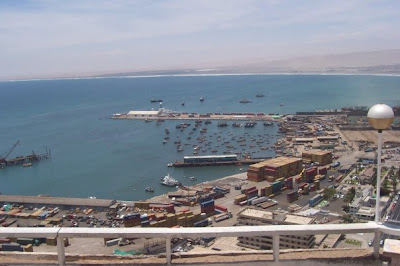Ruined
After we got back to Cuzco, we booked tickets to Puno, starting our way back to Chile. By this time, Ezra and I were all that remained of our original foursome- a pickpocket and a family emergency split our other companions off to their own obligations. We decompressed on the tranquil, six hour ride- the same ride that took 24 hours in the other direction.
In Puno, we caught a few sights on Lake Titicaca before moving on to Tacna for the border crossing.
The Yavari, Peru's English-made gunship,
150 years old and originally fueled by llama dung
(you can't make this stuff up)

Yavari to aft

A recipe for disaster

After Puno we caught a very luxurious overnight to Tacna for the border crossing. Everything's cheap in Peru- just before the bus left, we got tea, bowls of soup, and plates of rice and chicken for all of 50 cents, U.S. Our bus tickets were about the same price we were used to, so we were surprised when we climbed onboard to find huge, leather chairs with footrests which reclined almost flat. Nice work if you can get it.
In Tacna we caught up with our bad luck: now the cabbies were striking, and the scab who eagerly sought us out to take us to the border got an earful from his compadres, and a few (hopefully) playful whacks on the side of his car as we pulled away from the picket lines. Still, we made it to and through the border without trouble, and caught a Chilean cab from customs to Arica.
Arica is touted as an unknown hotspot for warm beaches in Chile- the Humbolt current which flows up the coast from Antarctica keeps most of Chile's shores too chilly for swimming, but it's supposed to veer off into the Pacific before reaching the northern sands. Ezra and I didn't find this to be true, but we did have a pretty fun day kicking around the city. Arica has a huge hill, El Morro de Arica, at the water's edge which was the site of a decisive battle of the War of the Pacific with Peru (another prideful museum boasts the country's victories). Just getting back from hauling our weary bones all over Machu Picchu and Waynapicchu, I found it ironic that one of the first things I did was climb to the top, but the view was formidable.
Arica's harbor from the top of El Morro
The next morning we caught a cheap flight back to Santiago, making the longest-distance trip of our spring vacation the shortest in duration. It had been tumultuous, terrifying, and sometimes agonizingly boring on all those buses, and one of the most exciting experiences of my life.
A few highlights from my notebook over that week:
Copies of Tiwanaku art from the Padre Le Paige Archaeological Museum:
A prestigious culture from modern-day Bolivia, the Tiwanaku established heavily-used trade routes south. They were peacefully incorporated into the Inca empire.
"Carved and burnt drawing in a wooden beam"
"Tiwanaku influenced textile"
Rubbing of the brass plaque on the captain's chair in the Yavari











No comments:
Post a Comment